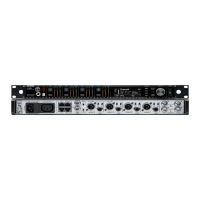
Do you have a question about the Shure AD4Q and is the answer not in the manual?
| Latency | 2.9 ms |
|---|---|
| Number of Channels | 4 |
| Audio Frequency Response | 20 Hz to 20 kHz |
| RF Sensitivity | -98 dBm at 10-5 BER |
| Power Requirements | 100 to 240 V AC, 50–60 Hz |
| Type | Digital Quad-Channel Wireless Receiver |
| Modulation | Shure proprietary digital |
| Spurious Rejection | > 80 dB |
| Image Rejection | > 80 dB |
| Audio Output | XLR |
| Network Interface | Ethernet 10/100 Mbps |
| Operating Temperature Range | -18°C (0°F) to +50°C (122°F) |
| Dynamic Range | 120 dB (A-weighted) |
Highlights core functionalities like wide tuning, low latency, HD mode, and Quadversity.
Lists all items provided with the receiver, such as cables and adapters.
Guidance on installing the receiver unit into an audio rack securely.
Details all controls, indicators, and connectors on the front of the receiver.
Describes the rear panel connectors, switches, and power inputs.
Explains how to access the main device settings menu.
Details how to access individual channel-specific menus.
Provides a visual map of the device configuration menu structure.
Overview screen for viewing selected channel settings and linked transmitters.
Describes how to use the channel menu to adjust gain, group, channel, and frequency.
Guide to selecting optimal tuning bands for local spectrum usage.
Steps for establishing a wireless link between transmitter and receiver.
Methods for finding available frequencies within a group or channel.
Procedure for manually selecting specific frequencies for channels.
Details on Standard and High Density modes for spectrum management.
How to register transmitters with receiver channels for RF signal control.
Covers detection modes, unregistered transmitter actions, and frequency server setup.
Configuring the receiver for four antenna inputs for enhanced coverage.
Managing DC bias for active antennas to prevent faults.
Adjusting receiver gain and controlling audio output on/off.
Using the built-in tone generator for sound checks and system tests.
Options for listening to receiver channels or Dante audio via headphones.
Configuring network interface, modes (Split/Redundant, Switched), and control software.
Steps for assigning automatic or manual IP addresses for network communication.
Discovering network devices and resolving network connectivity issues.
Assigning unique IDs and names for better system organization.
Securing controls and customizing display settings like brightness and sleep.
Automatically setting transmitter parameters via IR sync presets.
Enabling AES-256 encryption for secure audio transmission.
Managing the internal fan for temperature control (Auto/On modes).
Updating receiver and transmitter firmware for optimal performance.
Restoring the receiver to its default factory settings.
Addresses problems like no sound, distortion, range limits, and mismatches.
Strategies for minimizing interference and maximizing transmission range.
Identifying and resolving issues related to antenna connections or faults.
Details RF tuning, sensitivity, image rejection, and output latency.
Covers frequency response, signal-to-noise ratio, and harmonic distortion.
Information on operating temperatures, storage, and audio output gain.
Details XLR/TRS output types, impedance, and line/mic settings.
Covers dimensions, weight, power input, and thermal dissipation.
Information on network interface, addressing, and maximum cable length.
Details RF input impedance, rejection, bias voltage, and connector types.
Illustrates the wiring for XLR to 1/4" output conversion.
Lists available frequency bands and corresponding transmitter RF power output.
